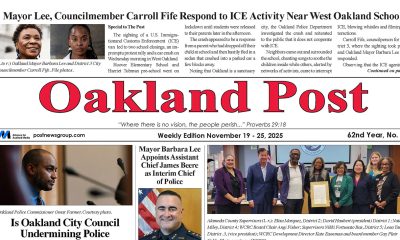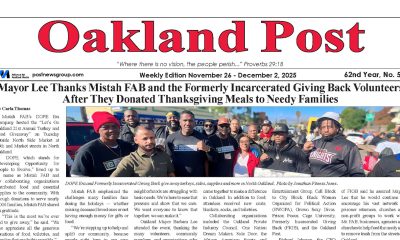#NNPA BlackPress
After Incarceration, Former Prisoners Face a Tough Journey Home to Find Work, Reunite with Family and Begin Again
NNPA NEWSWIRE — With tens of thousands of prisoners being released each year from jails and prisons across the country, experts agree that a major test on the journey home for these individuals is navigating rocky shoals of the transition between prison and society. Will they be productive citizens, or will they engage in a repeat offense and return to prison? Or will they end up homeless in the streets – or worse?
By Rachel Holloway, Trice Edney Newswire
Try to imagine what freedom must be like for many prisoners who’ve been released after serving sentences of 10, 15 or 20 years behind bars.
Sure, there is the initial sense of elation among some of the men and women about the prospect of a second chance in society. But that elation frequently gives way to frustration, dismay and even fear over how to begin picking up the pieces of their shattered lives.
Indeed, the questions and obstacles they face can be overwhelming. Will they ever find a job, especially if they lack the skills employers need? What about affordable housing? And where will they find money to pay for food and transportation?
Then there are all the societal changes, starting with the disappearance of transit tokens, not to mention the array of other new technologies, including smartphones, social media platforms, video streaming, e-readers, GPS devices and tablets. These technologies are often dizzyingly unfamiliar to individuals who in many cases went to prison at a time when the lowly flip phone was a high technological achievement. And yet, being able to use those technologies-from Microsoft Word for a resume to LinkedIn for job searching -is critical.
Thousands of ex-convicts face this reality in communities across the country, from Boston, New York City, Philadelphia, Washington, Atlanta and Miami to Chicago, Detroit, Houston and Los Angeles. To hear these sort of coming home stories is the first step to understand the daunting journey undertaken by these individuals – often unsuccessfully – to rebuild their lives and re-establish ties to family, friends and community after prison.
With tens of thousands of prisoners being released each year from jails and prisons across the country, experts agree that a major test on the journey home for these individuals is navigating rocky shoals of the transition between prison and society. Will they be productive citizens, or will they engage in a repeat offense and return to prison? Or will they end up homeless in the streets – or worse?
Ex-convicts continue to pay after release
How to help ease the transition for inmates returning home has become part of the growing national debate on reforming the criminal justice system at a time when critics say it has incarcerated a disproportionate number of Black and Hispanic men while focusing on punishment rather than rehabilitation.
That debate is playing out in Washington, D.C.’s predominantly black Ward 5, where a proposal to open a residential reentry facility for ex-prisoners has provoked a not-in-my-backyard furor. It has also sparked a larger discussion about the need for programs that confront systemic needs of ex-convicts-including providing housing, job training or drug treatment-while helping them work through the psychological issues that returning home can provoke.
At the center of this debate is CORE DC, a minority-owned, social-services group seeking to open a residential reentry center in Ward 5. The Federal Bureau of Prisons (BOP) on November 1, 2018 awarded CORE DC the contract to open a 300-bed center and the facility was scheduled to start taking in residents on March 1 of this year.
But plans were put on hold amid concerns from some community members. The delay dealt a blow to efforts to address the pressing needs of former inmates returning home with what CORE DC and supporters say is the organization’s humane approach to helping the former prisoners assimilate into a society with obsolete notions of crime and punishment.
“How do you genuinely engage in criminal justice reform when you still have ancient and outdated attitudes?” CORE DC chairman and CEO Jack Brown said. “These are the kind of monsters under the bed that CORE has to deal with. If you have an organization that is providing these services and their reputation is questionable, of course the community should have concerns. But that is not what the community is getting with CORE.”
Lingering concerns about past service providers
The only reentry center in Washington, D.C., today is Hope Village, located in Southeast Washington. Opened in the late 1970s, it has faced criticism in the past on issues ranging from the treatment of residents to its security practices. In a 53-page 2013 memo, the independent agency in charge of monitoring conditions inside of District correctional facilities found that Hope Village lacked “job readiness resources” and substandard care for residents with mental health needs. In 2016, a nonprofit criminal justice advocacy group called the Council for Court Excellence implored the BOP to end its contract with Hope Village.
When Northeast Washington residents got word that a new reentry center would open in Ward 5, some expressed reservations. Chief among their questions was whether CORE DC’s reentry home would be a good neighbor, a concern that seemingly reflected lingering concerns the community had from past experiences.
In fact, just weeks after CORE DC’s Ward 5 project was announced, two former Hope Village residents who had escaped and committed crimes were sentenced to prison, one for a 27-month term and the other for 33 months. The episode seemed to fuel falsehoods and misconceptions about the indispensable role that experts say transitional services such as temporary housing and job training have in ensuring former inmates have the tools needed for a second chance.
As the drip-drip of troubling reports coming out of Southeast Washington cast a dark shadow over a possible new reentry center in Northeast Washington, CORE DC reached out to local lawmakers while the organization’s leadership joined community hearings convened to address questions surrounding the planned facility.
CORE DC says it hoped to provide facts and clarity to the discussion.
“At our facilities, the program director is in daily communication with Bureau of Prisons,” Brown said. “Most people in the community believe you get to hang out from 8 a.m. to 9 p.m at outside of the center, not at CORE. We don’t see too many program failures because our clients have jobs that we work with them to get in the construction industry, technology sector and other livable wage jobs.”
But dialogue has sometimes been elusive-and sometimes heated.
Halfway houses, a loaded term
At one community meeting, a pamphlet was left behind that warned of the grave dangers of “halfway houses,” a term that those in the criminal-justice world say is outdated and filled with a negative connotation. “Halfway houses accept sex offenders, drug offenders, convicted murders and rapists,” the pamphlet read. A group of 12 Northeast residents sued, and on December 21, CORE DC lost its lease on the property.
There is also the fact that Hope Village, which has won more than $125 million in federal contracts since 2006, filed a protest against the BOP contract with CORE DC. The protest, filed with the Government Accountability Office (GAO), leveled a number of charges, including that Hope Village lost the contract because it refused to take in sex offenders. In a decision made on Feb. 21, the GAO dismissed Hope Village’s highly charged claim, while raising technical questions about CORE DC’s use of the property it proposed for its center.
CORE DC said that it remains committed to the DC area.
“We remain committed to reunifying the families and restoring the communities that these individuals leave behind,” Brown said, “But in order to address these complicated issues, the community deserves a productive, fact-driven dialogue, not falsehoods and fear-mongering.”
In recent weeks, CORE Services Group, of which CORE DC is an affiliate, has invited Ward 5 leaders to tour other reentry centers the organization operates. The nonprofit, founded in 2005, has invited local representatives to a reentry center in Brooklyn, New York, where security standards have been lauded in routine reviews by the BOP.
Meanwhile, it remains to be seen whether the community will embrace CORE DC as a new neighbor. But with an estimated 8,000 former inmates returning home to Washington every year, advocates say reentry centers are a proven part of the solution, even as they caution that the District, just like communities around the country, need a comprehensive approach.
The writer, Rachel Holloway, can be contacted at holloway75@gmail.com.
#NNPA BlackPress
A Nation in Freefall While the Powerful Feast: Trump Calls Affordability a ‘Con Job’
BLACKPRESSUSA NEWSWIRE — There are seasons in this country when the struggle of ordinary Americans is not merely a condition but a kind of weather that settles over everything.

By Stacy M. Brown
Black Press USA Senior National Correspondent
There are seasons in this country when the struggle of ordinary Americans is not merely a condition but a kind of weather that settles over everything. It enters the grocery aisle, the overdue bill, the rent notice, and the long nights spent calculating how to get through the next week. The latest numbers show that this season has not passed. It has deepened.
Private employers cut 32,000 jobs in November, according to ADP. Because the nation has been hemorrhaging jobs since President Trump took office, the administration has halted publishing the traditional monthly report. The ADP report revealed that small businesses suffered the heaviest losses. Establishments with fewer than 50 workers shed 120,000 positions, including 74,000 from companies with 20 to 49 workers. Larger firms added 90,000 jobs, widening the split between those rising and those falling.
Meanwhile, wealth continues to climb for the few who already possess most of it. Federal Reserve data shows the top 1 percent now holds $52 trillion. The top 10 percent added $5 trillion in the second quarter alone. The bottom half gained only 6 percent over the past year, a number so small it fades beside the towering fortunes above it.
“Less educated and poorer people tend to make worse mistakes,” John Campbell said to CBS News, while noting that the complexity of the system leaves many families lost before they even begin. Campbell, a Harvard University economist and coauthor of a book examining the country’s broken personal finance structure, pointed to a system built to confuse and punish those who lack time, training, or access.
“Creditors are just breathing down their necks,” Carol Fox told Bloomberg News, while noting that rising borrowing costs, shrinking consumer spending, and trade battles under the current administration have left owners desperate. Fox serves as a court-appointed Subchapter V trustee in Southern Florida and has watched the crisis unfold case by case.
During a cabinet meeting on Tuesday, Trump told those present that affordability “doesn’t mean anything to anybody.” He added that Democrats created a “con job” to mislead the public.
However, more than $30 million in taxpayer funds reportedly have supported his golf travel. Reports show Kristi Noem and FBI Director Kash Patel have also made extensive use of private jets through government and political networks. The administration approved a $40 billion bailout of Argentina. The president’s wealthy donors recently gathered for a dinner celebrating his planned $300 million White House ballroom.
During an appearance on CNBC, Mark Zandi, an economist, warned that the country could face serious economic threats. “We have learned that people make many mistakes,” Campbell added. “And particularly, sadly, less educated and poorer people tend to make worse mistakes.”
#NNPA BlackPress
The Numbers Behind the Myth of the Hundred Million Dollar Contract
BLACKPRESSUSA NEWSWIRE — Odell Beckham Jr. did not spark controversy on purpose. He sat on The Pivot Podcast and tried to explain the math behind a deal that looks limitless from the outside but shrinks fast once the system takes its cut.

By Stacy M. Brown
Black Press USA Senior National Correspondent
Odell Beckham Jr. did not spark controversy on purpose. He sat on The Pivot Podcast and tried to explain the math behind a deal that looks limitless from the outside but shrinks fast once the system takes its cut. He looked into the camera and tried to offer a truth most fans never hear. “You give somebody a five-year $100 million contract, right? What is it really? It is five years for sixty. You are getting taxed. Do the math. That is twelve million a year that you have to spend, use, save, invest, flaunt,” said Beckham. He added that buying a car, buying his mother a house, and covering the costs of life all chip away at what people assume lasts forever.
The reaction was instant. Many heard entitlement. Many heard a millionaire complaining. What they missed was a glimpse into a professional world built on big numbers up front and a quiet erasing of those numbers behind the scenes.
The tax data in Beckham’s world is not speculation. SmartAsset’s research shows that top NFL players often lose close to half their income to federal taxes, state taxes, and local taxes. The analysis explains that athletes in California face a state rate of 13.3 percent and that players are also taxed in every state where they play road games, a structure widely known as the jock tax. For many players, that means filing up to ten separate returns and facing a combined tax burden that reaches or exceeds 50 percent.
A look across the league paints the same picture. The research lists star players in New York, Philadelphia, Chicago, Detroit, and Cleveland, all giving up between 43 and 47 percent of their football income before they ever touch a dollar. Star quarterback Phillip Rivers, at one point, was projected to lose half of his playing income to taxes alone.
A second financial breakdown from MGO CPA shows that the problem does not only affect the highest earners. A $1 million salary falls to about $529,000 after federal taxes, state and city taxes, an agent fee, and a contract deduction. According to that analysis, professional athletes typically take home around half of their contract value, and that is before rent, meals, training, travel, and support obligations are counted.
The structure of professional sports contracts adds another layer. A study of major deals across MLB, the NBA, and the NFL notes that long-term agreements lose value over time because the dollar today has more power than the dollar paid in the future. Even the largest deals shrink once adjusted for time. The study explains that contract size alone does not guarantee financial success and that structure and timing play a crucial role in a player’s long-term outcomes.
Beckham has also faced headlines claiming he is “on the brink of bankruptcy despite earning over one hundred million” in his career. Those reports repeated his statement that “after taxes, it is only sixty million” and captured the disbelief from fans who could not understand how money at that level could ever tighten.
Other reactions lacked nuance. One article wrote that no one could relate to any struggle on eight million dollars a year. Another described his approach as “the definition of a new-money move” and argued that it signaled poor financial choices and inflated spending.
But the underlying truth reaches far beyond Beckham. Professional athletes enter sudden wealth without preparation. They carry the weight of family support. They navigate teams, agents, advisors, and expectations from every direction. Their earning window is brief. Their career can end in a moment. Their income is fragmented, taxed, and carved up before the public ever sees the real number.
The math is unflinching. Twenty million dollars becomes something closer to $8 million after federal taxes, state taxes, jock taxes, agent fees, training costs, and family responsibilities. Over five years, that is about $40 million of real, spendable income. It is transformative money, but not infinite. Not guaranteed. Not protected.
Beckham offered a question at the heart of this entire debate. “Can you make that last forever?”
#NNPA BlackPress
FBI Report Warns of Fear, Paralysis, And Political Turmoil Under Director Kash Patel
BLACKPRESSUSA NEWSWIRE — Six months into Kash Patel’s tenure as Director of the Federal Bureau of Investigation, a newly compiled internal report from a national alliance of retired and active-duty FBI agents and analysts delivers a stark warning about what the Bureau has become under his leadership.

Six months into Kash Patel’s tenure as Director of the Federal Bureau of Investigation, a newly compiled internal report from a national alliance of retired and active-duty FBI agents and analysts delivers a stark warning about what the Bureau has become under his leadership. The 115-page document, submitted to Congress this month, is built entirely on verified reporting from inside field offices across the country and paints a picture of an agency gripped by fear, divided by ideology, and drifting without direction.
The report’s authors write that they launched their inquiry after receiving troubling accounts from inside the Bureau only four months into Patel’s tenure. They describe their goal as a pulse check on whether the ninth FBI director was reforming the Bureau or destabilizing it. Their conclusion: the preliminary findings were discouraging.
Reports Describe Widespread Internal Distrust and Open Hostility Toward President Trump
Sources across the country told investigators that a large number of FBI employees openly express hostility toward President Donald Trump. One source reported seeing an “increasing number of FBI Special Agents who dislike the President,” adding that these employees were exhibiting what they called “TDS” and had lost “their ability to think critically about an issue and distinguish fact from fiction.” Another source described employees making off-color comments about the administration during office conversations.
The sentiment reportedly extends beyond domestic lines. Law enforcement and intelligence partners in allied countries have privately expressed fear that the Trump administration could damage long-term international cooperation according to a sub-source who reported those concerns directly to investigators.
Pardon Backlash and Fear of Retaliation
The President’s January 20 pardons of individuals convicted for their roles in the January 6 attack ignited what the report calls demoralization inside the Bureau. One FBI employee said they were “demoralized” that individuals “rightfully convicted” were pardoned and feared that some of those individuals or their supporters might target them or their family for carrying out their duties. Another source described widespread anger that lists of personnel who worked on January 6 investigations had been provided to the Justice Department for review, noting that agents “were just following orders” and now worry those lists could leak publicly.
Morale In Decline
Morale among FBI employees appears to be sinking fast. There were a few scattered positive notes, but the weight of the reporting describes morale as low, bad, or terrible. Agents with more than a decade of service told investigators they feel marginalized or ignored. Some are counting the days until they can retire. One even uses a countdown app on their phone.
Culture Of Fear
Layered over that unhappiness is something far more corrosive. A culture of fear. Sources say Patel, though personable, created mistrust from the start because of harsh remarks he made about the FBI before taking office. Agents took those comments personally. They now work in an atmosphere where employees keep their heads down and speak carefully. Managers wait for directions because they are afraid a wrong move could cost them their jobs. One source said agents dread coming to work because nobody knows who will be reassigned or fired next.
Leadership Concerns
The report also paints a picture of leaders unprepared for the jobs they hold. Multiple sources said Patel is in over his head and lacks the breadth of experience required to understand the Bureau’s complex programs. Some said Deputy Director Dan Bongino should never have been appointed because the role requires deep institutional knowledge of FBI operations. A sub-source recounted Bongino telling employees during a field office visit that “the truth is for chumps.” Employees who heard it were stunned and offended.
Social Media and Communication Breakdowns
Communication inside the Bureau has become another source of frustration. Sources said Patel and Bongino spend too much time posting on social media and not enough time communicating with employees in clear and official ways. Several told investigators they learn more about FBI operations from tweets than from internal channels.
ICE Assignments Raise Alarm
Nothing has sparked more frustration inside the FBI than the orders requiring agents to assist Immigration and Customs Enforcement. The reporting shows widespread resentment and fear over these assignments. Agents say they have little training in immigration law and were ordered into operations without proper planning. Some said they were put in tactically unsafe positions. They also warned that being pulled away from counterterrorism and counterintelligence investigations threatens national security. One sub-source asked, “If we’re not working CT and CI, then who is?”
DEI Program Removal
Even the future of diversity programs became a point of division. Some agents praised Patel’s removal of DEI initiatives. Others said the old system left them afraid to speak honestly because they worried about being labeled racist. The reporting shows a deep and unresolved conflict over whether DEI strengthened the organization or weakened it.
Notable Incidents
The document also details several incidents that have become part of FBI lore. Patel ordered all employees to remove pronouns and personal messages from their email signatures yet used the number nine in his own. Agents laughed at what they saw as hypocrisy. In another episode, FBI employees who discussed Patel’s request for an FBI-issued firearm were ordered to take polygraph examinations, which one respected source described as punitive. And in Utah, Patel refused to exit a plane without a medium-sized FBI raid jacket. A team scrambled to find one and finally secured a female agent’s jacket. Patel still refused to step out until patches were added. SWAT members removed patches from their own uniforms to satisfy the demand.
A Bureau at a Crossroad
The Alliance warns that the Bureau stands at a difficult crossroads. They write that the FBI faces some of the most daunting challenges in its history. But even in despair, a few voices say something different. One veteran source said “It is early, but most can see the mission is now the priority. Case work and threats are the focus again. Reform is headed in the right direction.”
-

 Activism4 weeks ago
Activism4 weeks agoOakland Post: Week of November 19 – 25, 2025
-

 #NNPA BlackPress3 weeks ago
#NNPA BlackPress3 weeks agoLIHEAP Funds Released After Weeks of Delay as States and the District Rush to Protect Households from the Cold
-

 #NNPA BlackPress4 weeks ago
#NNPA BlackPress4 weeks agoBeyoncé and Jay-Z make rare public appearance with Lewis Hamilton at Las Vegas Grand Prix
-

 Alameda County2 weeks ago
Alameda County2 weeks agoSeth Curry Makes Impressive Debut with the Golden State Warriors
-

 Activism3 weeks ago
Activism3 weeks agoOakland Post: Week of November 26 – December 2, 2025
-

 #NNPA BlackPress3 weeks ago
#NNPA BlackPress3 weeks agoSeven Steps to Help Your Child Build Meaningful Connections
-

 #NNPA BlackPress3 weeks ago
#NNPA BlackPress3 weeks agoSeven Steps to Help Your Child Build Meaningful Connections
-

 #NNPA BlackPress4 weeks ago
#NNPA BlackPress4 weeks agoLewis Hamilton set to start LAST in Saturday Night’s Las Vegas Grand Prix




















































